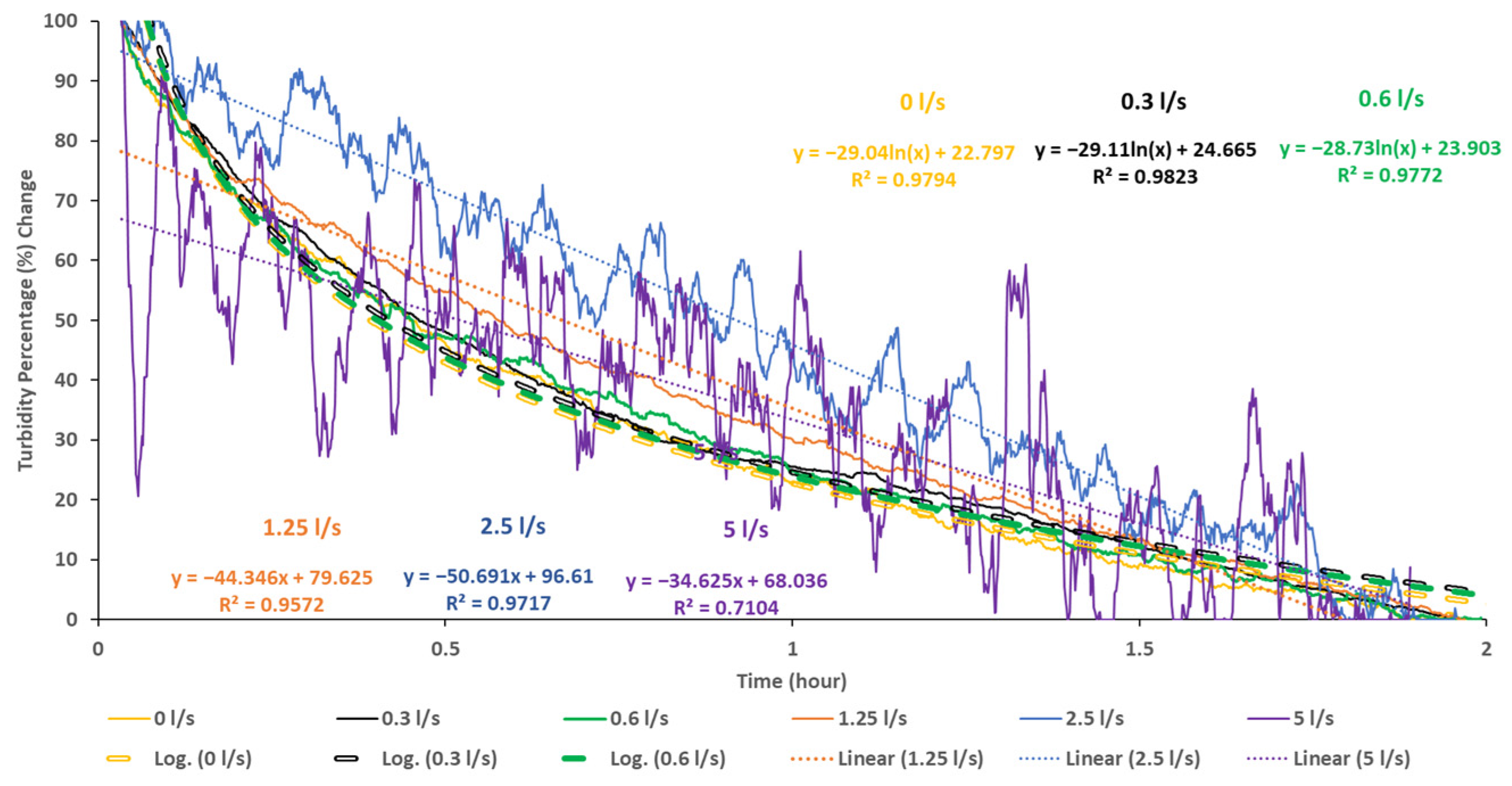Identifying Hydraulic Conditions for Discolouration Material Accumulation †
Abstract
1. Introduction
2. Materials and Methods
2.1. Experimental Plan
2.2. Discolouration Material
2.3. Hydraulic Conditions Investigated
3. Results and Discussion
3.1. Quantifying Hydraulic Conditions and Turbidity Decrease
3.2. Identifying Change in Turbidity Decay Pattern
4. Conclusions
Author Contributions
Funding
Institutional Review Board Statement
Informed Consent Statement
Data Availability Statement
Acknowledgments
Conflicts of Interest
References
- DWI. The Chief Inspector’s Report for Drinking Water in England; Drinking Water Inspectorate Nobel House: London, UK, 2020.
- Boxall, J.; Blokker, M.; Schaap, P.; Speight, V.; Husband, S. Managing discolouration in drinking water distribution systems by integrating understanding of material behaviour. Water Res. 2023, 243, 120416. [Google Scholar] [CrossRef] [PubMed]
- Blokker, M.; Vreeburg, J.H.; Schaap, P.; van Dijk, J.C. The Self-Cleaning Velocity in Practice. In Proceedings of the WDSA 2010, Tucson, AZ, USA, 12–15 September 2010. [Google Scholar]
- Ryan, G.; Mathes, P.; Haylock, G.; Jayaratne, A.; Wu, J.; Noui-Mehidi, N.; Grainger, C.; Nguyen, B.V. Particles in Water Distribution Systems: Characterisation of Particulate Matter in Drinking Water Supplies; Cooperative Research Centre for Water Quality and Treatment: Salisbury, Australia, 2008. [Google Scholar]
- Braga, A.S.; Filion, Y. The interplay of suspended sediment concentration, particle size and fluid velocity on the rapid deposition of suspended iron oxide particles in PVC drinking water pipes. Water Res. X 2022, 15, 100143. [Google Scholar] [CrossRef] [PubMed]
- Boxall, J.; Skipworth, P.J.; Saul, A.J. A Novel Approach to Modelling Sediment Movement in Distribution Mains Based on Particle Characteristics. In Proceedings of the Computing and Control for the Water Industry, Leicester, UK, 3–5 September 2001. [Google Scholar]
- Van Thienen, P.; Vreeburg, J.H.; Blokker, M. Radial Transport Processes as a Precursor to Particle Deposition in Drinking Water Distribution Systems. Water Res. 2011, 45, 1807–1817. [Google Scholar] [CrossRef] [PubMed]


| Flow (L/s) | Velocity (m/s) | Reynolds Nr ≈ (at 10 C) | Shear Stress (N/m2) | Average Turbidity Decrease (%) | Proposed Accumulation Process |
|---|---|---|---|---|---|
| 0 | 0 | 0 | 0 | 20.6 | Sedimentation |
| 0.3 | 0.06 | 3600 | 0.015 | 34.5 | Sedimentation, cohesive layers |
| 0.6 | 0.12 | 7200 | 0.055 | 28.5 | Less sedimentation, more cohesive layers |
| 1.25 | 0.25 | 15,000 | 0.213 | 28.5 | Some sedimentation, more cohesive layers |
| 2.5 | 0.50 | 30,000 | 0.768 | 10.2 | Cohesive layers |
| 5 | 1.00 | 60,000 | 2.770 | 4.0 | Cohesive layers |
Disclaimer/Publisher’s Note: The statements, opinions and data contained in all publications are solely those of the individual author(s) and contributor(s) and not of MDPI and/or the editor(s). MDPI and/or the editor(s) disclaim responsibility for any injury to people or property resulting from any ideas, methods, instructions or products referred to in the content. |
© 2024 by the authors. Licensee MDPI, Basel, Switzerland. This article is an open access article distributed under the terms and conditions of the Creative Commons Attribution (CC BY) license (https://creativecommons.org/licenses/by/4.0/).
Share and Cite
Lokk, R.; Boxall, J.; Husband, S. Identifying Hydraulic Conditions for Discolouration Material Accumulation. Eng. Proc. 2024, 69, 190. https://doi.org/10.3390/engproc2024069190
Lokk R, Boxall J, Husband S. Identifying Hydraulic Conditions for Discolouration Material Accumulation. Engineering Proceedings. 2024; 69(1):190. https://doi.org/10.3390/engproc2024069190
Chicago/Turabian StyleLokk, Reinar, Joby Boxall, and Stewart Husband. 2024. "Identifying Hydraulic Conditions for Discolouration Material Accumulation" Engineering Proceedings 69, no. 1: 190. https://doi.org/10.3390/engproc2024069190
APA StyleLokk, R., Boxall, J., & Husband, S. (2024). Identifying Hydraulic Conditions for Discolouration Material Accumulation. Engineering Proceedings, 69(1), 190. https://doi.org/10.3390/engproc2024069190






